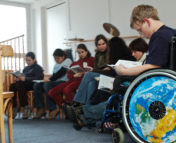Title: Queering methodologies in physics education research
Author: Madison Swirtz (they/them) and Ramón Barthelemy (he/him)
First Author’s Institution: University of Utah, Salt Lake City
Status: Presented at Physics Education Research Conference 2022 [open access]
Physics education research (PER) is the study of how physics is taught and how to make its teaching effective for all physics students. A lot of this research involves either quantitative, i.e. counting statistics from surveys, or qualitative work, i.e. interviewing participants about their experiences. With more and more people looking into how to make physics education more equitable, diverse, and inclusive, recent research has focussed on studying underrepresented groups’ experiences in physics learning environments. But are the questions we are asking in PER the right questions we really need to make physics education better for minoritised students? Today’s paper looks at how ideas from queer theory can be used in PER to improve the reality of physics education.
What is ‘queering research methods’?
The paper defines “to queer” as:
“to make strange, to frustrate, to counteract, to delegitimize, to camp up heteronormative knowledges and institutions.”
In other words, queering encompasses both the definitions of the unexpected and non-conforming, and of resisting society’s traditional ideas about gender or sexuality. Queering research methods specifically means breaking into (and apart) the approach to a research question: as being queer is existing and thinking outside mainstream heteronormative society, queering research methods means approaching a research problem from a completely different angle. Additionally, queer methods look at deconstructing how research methods yield to the heteronormative status quo prevailing in institutional academia.
This definition highlights some of the contradictions between queer theory and current methods in PER:
‘To count is to agree that there is a well-bounded definition’.
Lived identities and experiences are often obscure and nebulous, and it’s hard to create finite categories to encompass all identities. How do you count everyone in a survey without leaving someone out and diminishing their experience?
‘To summarise and analyse is to impose your own values onto your research participants’.
Understanding results from studies often requires relating these back to the perspective of the researcher. How can we empower the participants of PER studies?
‘To report on your findings is an attempt to assimilate yourself into the heteronormative culture of the academy’.
When dealing with funding sources and institutional goals, how can researchers resist institutional status quo? How much of the structure of the academy can truly be changed to help minoritised students?
This doesn’t just have to relate to research methods in PER, the paper also highlights how special relativity has queered kinematics by requiring a reconceptualisation of physics as it was known previously. Playing around, making physics strange, twisting and breaking it apart has revolutionised modern physics. Queering physics is essential for understanding our universe.
Queering quantitative methods
Some quantitative research can have a positive impact on diversity issues, for example a survey of the demographics of introductory physics students found that these students did not fit typically assumed categories of white men learning calculus-based physics at high-ranking universities. However, qualitative research can also cause trouble when assigning participants into categories. For example, non-binary people are often overlooked in surveys only referring to binary gender.
In queer theory, gender can be better understood as a wider combination of people’s experiences. Quantitative studies can reduce a person’s whole experience to one dimension, leaving out the important intersection between identities such as how race and gender combined affect a person’s experience in STEM spaces. Today’s paper quotes an example of how nerd culture is often associated with a certain image restricted to white and Asian men, while it is gatekept from people who don’t fit that stereotype. These are the types of identities that typical surveys do not consider but that a queer research framework can highlight.
Additionally, because physics environments are overwhelmingly male, white, heterosexual, and cisgender, a survey that averages over all identities other than gender will be biased towards white, heterosexual, and cisgender populations. This quantitative research would then, when looking at the experience of a woman in physics, result in only understanding the experience of cisgender straight white women. This leaves women of colour and transgender women’s experiences unaccounted for when suggesting improvements to make in physics education.
The paper makes some suggestions that quantitative surveys need to consider: make sure surveys don’t reinforce binary categories and allow self-identification so no-one is excluded; the methods should be chosen based on research goals; and the pool of participants should be sufficiently diverse and include gender non-conforming participants. In general, just as should be done in other areas of physics and astronomy research, queering quantitative research means questioning the limitations and the assumptions of the data you are studying.
Making qualitative research fun!
In terms of qualitative research, the paper outlines some innovative research methods from previous studies. These methods particularly emphasise the effectiveness of empowering participants and giving them more control of their story, opening up the walls beyond question and response into something more expressive and personal.
These methods include basing research off of the researcher’s personal experiences in a reflective autoethnography, and inviting queer students of colour to photograph the places, people, and things that made them feel a sense of belonging. Other studies hold pre-interviews with participants so that the participants can understand the researchers goals, methods, and biases, while the researcher can learn to improve their own study.
Breaking down the researcher/participant binary in turn allows breaking down of power structures, allows for more honesty in qualitative research, and adds richness and complexity to these studies. The creative approach of making qualitative research fun for participants will hopefully give a new level of understanding to how students enjoy learning in physics, in turn pointing out the next improvements to make to physics education.
Conclusion
The paper introduces queering methods as something paradoxical; methods which are rigid, well defined, and require conformity cause tension with the definition of queering, seemingly the opposite, undefined, fluid and expansive. But when thinking of queering methods as breaking apart existing methods and exposing contradictions, new innovative discoveries can grow from these paradoxes, just like special relativity from kinematics. The queer contradiction continues in modern physics with the paradox between quantum mechanics and general relativity. Working with these contradictions both in queering physics education and queering physics concepts will pioneer the road for future research and for the experiences of future researchers.
Astrobite edited by Yoni Brande
Featured Image Credit: Art by Storm Colloms





Very interesting astrobite in areas of physics and queer theory I’m not familiar with. I like how many astrobites combine notions about identity and social issues in STEM contexts.
Thank you Peter!
As an astronomy student who is also non-binary in University of Glasgow, I really enjoyed reading this! Thank you for bringing this to light.
Thank you, that means a lot!